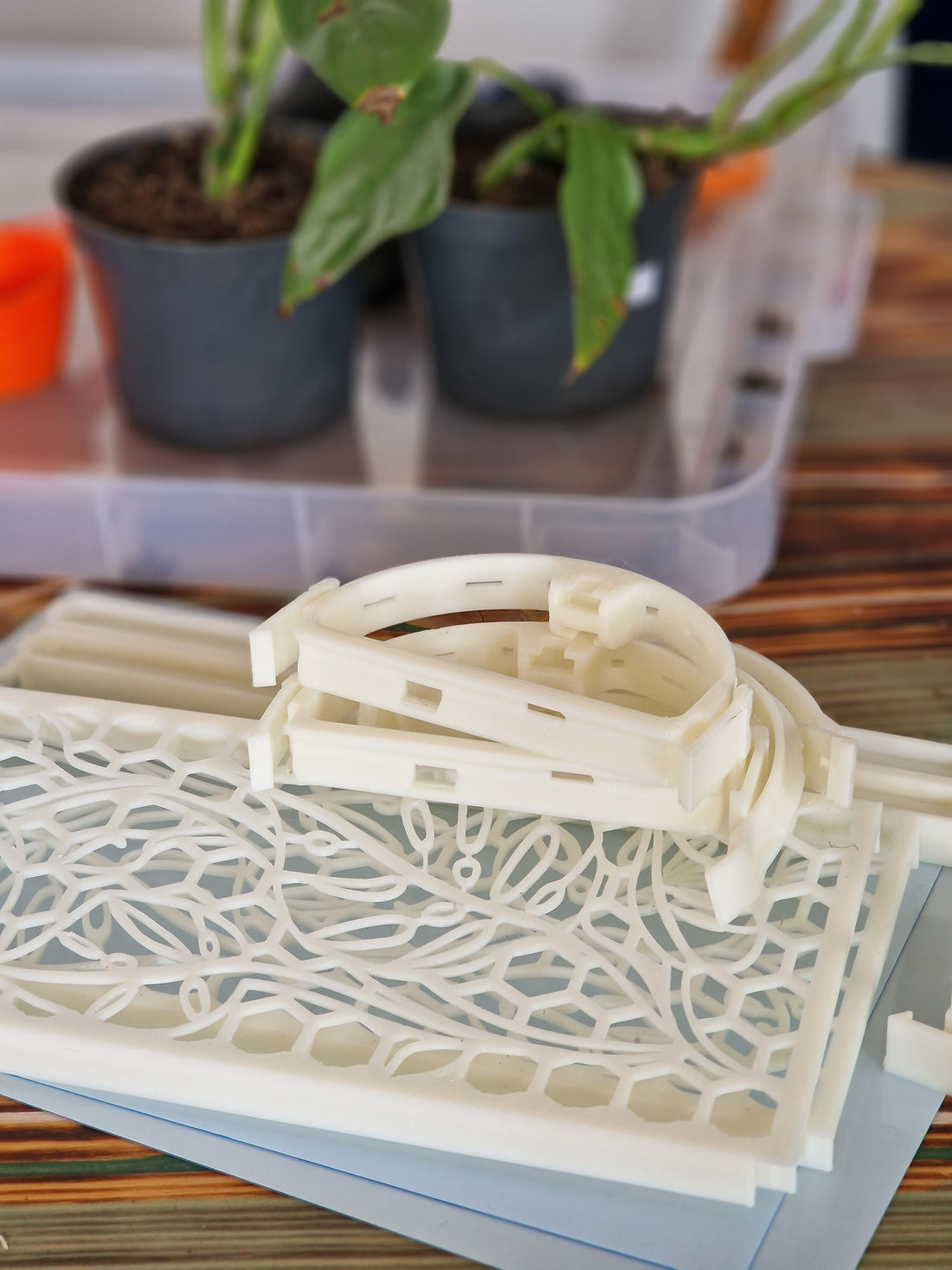
D-Shaped Moss Pole pot-up - Moss trellis guide
Share
Right! You've bought a D-shaped moss pole, or are thinking about it (do it!), and want to know more about how to go about using it. Our goal and design target has always been to make our products fun and easy to use.
For this very reason we have gone through various iterations to find out, not only what is the best way to put these moss poles together while planting, but also how to make extending them a breeze, after your plant has outgrown its pole.
If you've selected a D-shaped pole, you know that the main feature this type has to distinguish it from other moss poles is the single open face. The semi-circular structure is enclosed on the back, keeping the moss moist longer, and encouraging plant growth on a single, front-facing, plane. This will allow for single facing walls of greenery, growing towards (ideally) your light source.
So let's get to work!
Frame assembly

Some tips to note:
- Some of the snaps and joints are quite stiff - this is intentional! Use gloves if you are struggling to unclasp joints, and a dull butter knife might help with wedging parts apart.

- Some gentle wiggling will get parts inserted or disconnected as needed - plastic is quite flexible and you should not need a lot of force to connect or disconnect the parts.
- You may want to complete and fill one module at a time, or you'll find you need to push your moss down several lengths of moss pole to get it filled!
- Don't be afraid to reach out to us if you have any questions! You can use our in-shop chat, we will get back to you as soon as possible.
Plant Preparation:
Once you've sourced your forward facing beauties, it is time to clean the old soil off the roots, check for possible rot, splitting off of baby plants (these drain the mother of nutrients, slowing growth), and if there are any nasty surprises in the soil (netting, plastics, etc.).

I like to use an old chopstick to tease root balls apart, and I'll try to pick off any moss that might be stuck to the roots as these can become swampy pockets of water, and I simply won't abide that.

Much better!
Zip-tie moss pole to pot:
If you are able to disturb the soil of your plant, and NOT adding a moss pole to an established plant, you'll want to fasten the moss pole to the pot using zip-ties, as this will ensure your moss pole will remain stable and perpendicular as it grows in height.
If you have no desire to disturb the roots of your established plant, you may also simply push the moss pole stakes into the soil of your plant, and then strap the plant to the frame itself (for this method, build the whole frame following the videos, and fill it with moss).
To begin, build the base module with the stakes, following the diagram above. The next step is to trim the stake to the depth allowed by the pot you've selected. This can be done best with some heavy garden snips, or flush cutters. Watch for the flying cut-off!

The size I've selected here is a 15 cm (about 6") orchid pot. I only use clear pots if I can help it, as it allows me to keep the moisture and root growth under control, as well as making this assembly easier.
Position the pole inside the pot, and mark the locations you will need to cut slots in the pot. I've marked them in light blue, the horizontal slots are placed one on the zip slot, one below:

Make sure you've held the moss pole perpendicular to the pot, as the position of the slots will dictate how straight your moss pole is once fastened.
Time to cut! I like using a thin tool end on a soldering iron, though do it in a well-ventilated location, and beware of the spicy hot melting end.

Another way to make the slots is to use a 4 or 5 mm bit and drill, as there is no need for the holes to be straight edged.
ENSURE THE CLEAR SHEET IS PLACED ON THE MODULE BEFORE THE NEXT STEP.
Now for the somewhat tricky part. Use your smallest hands and longest fingers to tease the zips through the slots you've made, and back out to latch closed. IMPORTANT- Don't pull them tight just yet, otherwise you'll have a hard time getting the remaining zips in place.


Once all the zips are in place and loosely fastened you can pull them tight, keeping the moss pole in the position you hope to have it, ideally straight.

Moss and strap:
Your base module is ready, if you've followed the video, and you are ready to fill it with the moss of your choosing.
While I started out using dehydrated bricks of sphagnum moss for vivariums, as soon as I sourced fresh moss I was instantly converted! The lovely colours and fresh scent makes it a much more welcome medium, but don't worry if you are unable to find it locally.

It should not be too tightly compacted, as you want even the weakest of roots to be able to squeeze into the moss, and start to drink of the moisture; you still want it loose enough to ensure that the moss is filled with little pockets of oxygen.

If you are adding this moss pole to an already potted up plant, at this stage you would simply push the stakes gently into the soil, taking care not to force them through the roots. What has worked best for me, if you have the option to work with a plant that has had the soil removed, is to strap the plant to the moss pole before adding soil. This allows you to manoeuvre the "back" of the stem, where the aerial roots protrude, towards the face of the moss pole. This can be done before or after adding the moss.

This allows you to align the back of the stem, the surface where the aerial roots will grow from, to the open areas where they will be close to the damp moss.

If you strap the plant to the frame first, you should be able to see the little aerial roots ready to come in contact with the moss.
Substrate and Water:
Next comes substrate, which feels like a bit of a reversal of the natural order. Whether or not you have zipped your moss pole to your pot, you're ready to get those roots covered by a well-draining mix.

My mix is very chunky, very little of it being actual soil, as the feeding of the plant will take place both from the buried roots, and from the roots making their home in the moss. This means I will need to add some plant food to the water used to hydrate the moss, because the moss itself does not supply enough nutrients to sustain the plant. In this way, even if the pot itself remains the same small size, the growth of the plant will not be stunted by being root bound, as it will have a whole array of well-fed aerial roots to draw nutrients through. You can think of the moss pole as an extension to the pot.

She is ready to water! You need not be as careful about root rot with this type of soil mix, just be sure to allow the water to drain completely out of the pot, and don't let it sit in a pool in the planter.
You'll be watering your moss thoroughly, and while the moss is not actually in contact with the soil in our D-Shaped moss pole, it may drip into the pot if you use a lot of water.
Best be safe and allow your pot to fully drain while sat on a rack before putting it back in its fancy planter. Alternatively, look into using one of our planters, which have a built-in drainage mesh and cache plate :)
Happy planting!
Legacy Frame Assembly Videos:
If you've bought your kit before the summer of 2024, or are extending a pole purchased before that date, you can follow the following instructions.
Short version - With zips
More in depth - no zips, stake only



